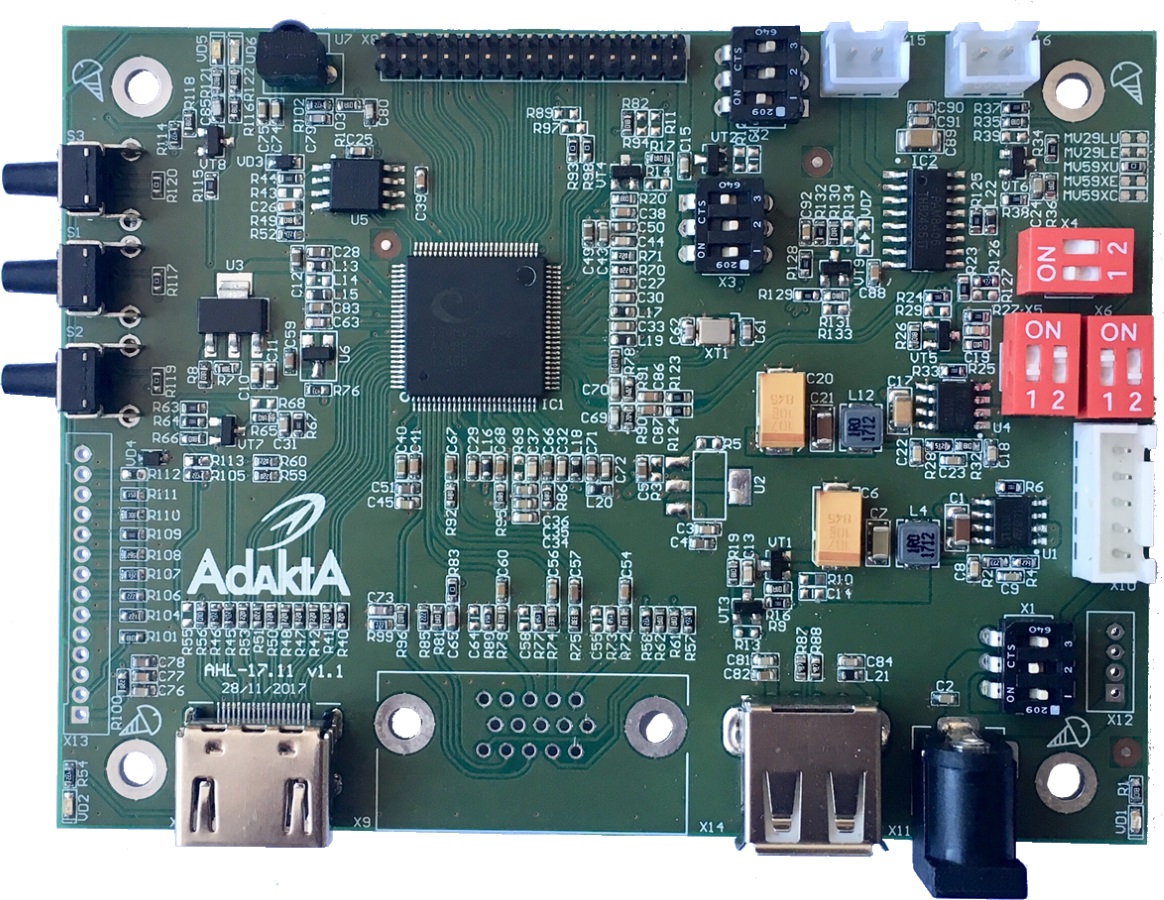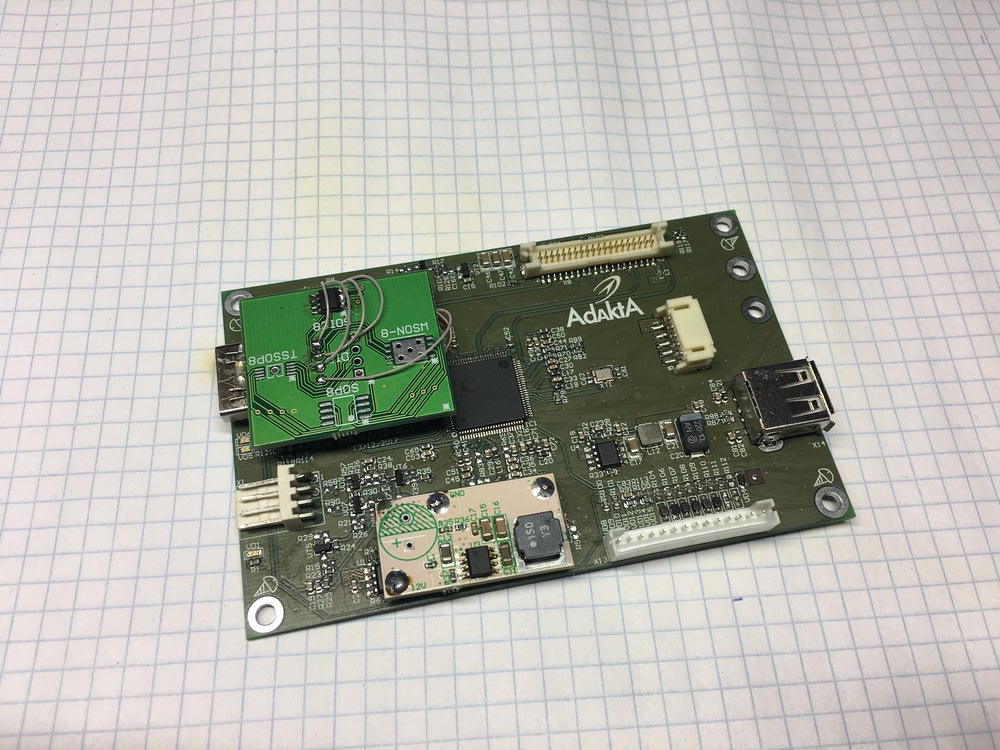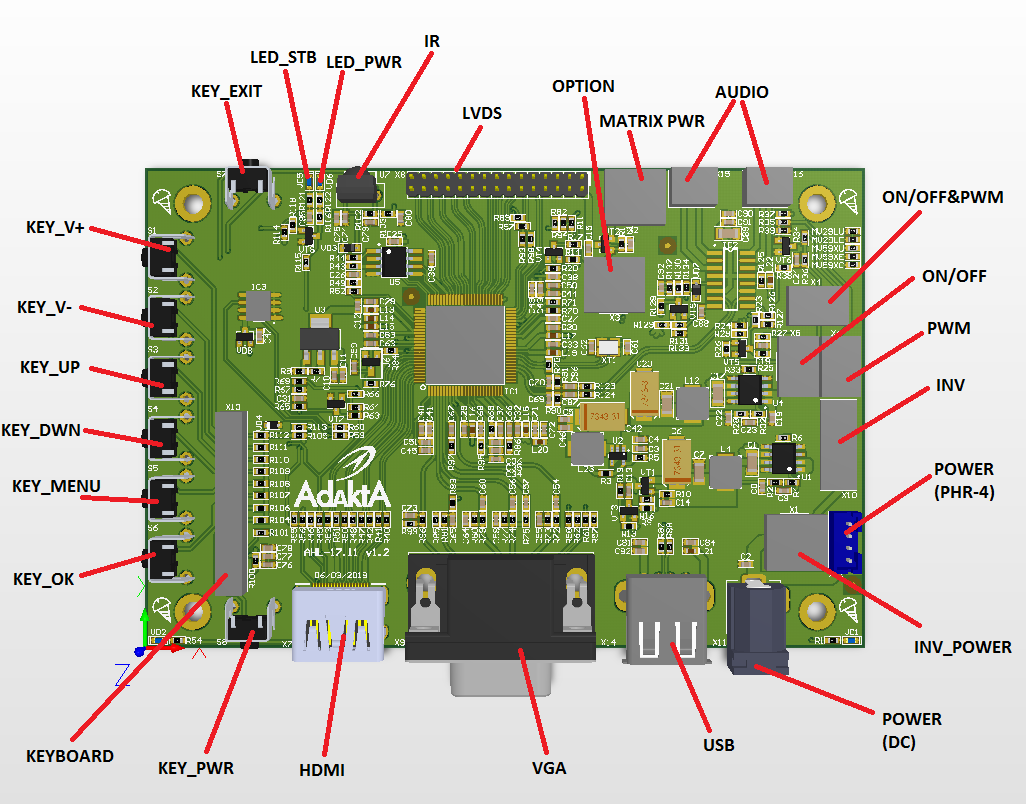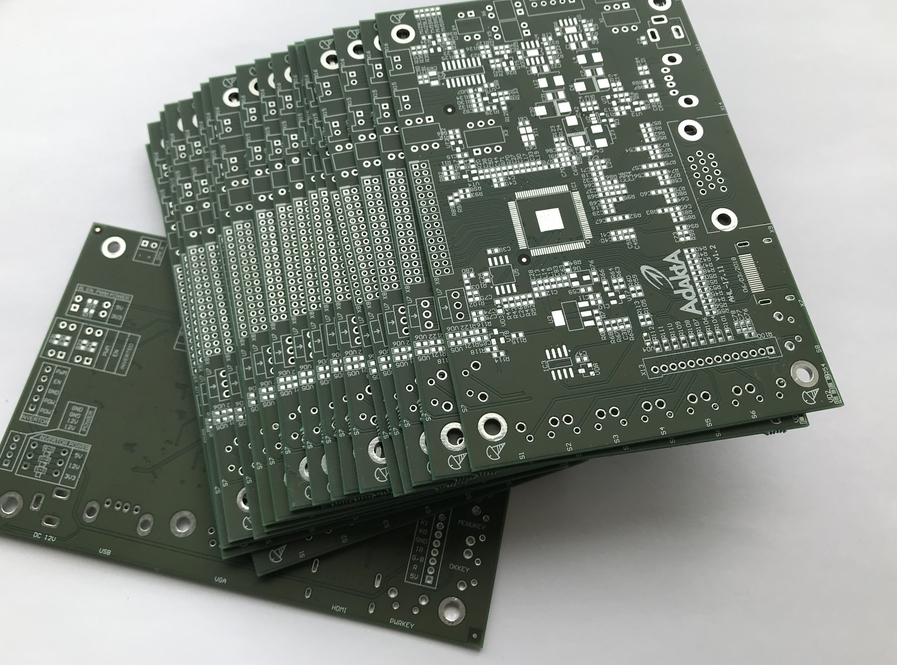HDMI-LVDS. Development on TSUMV59 from MStar
Good day, Habr!

In continuation of the last article on the subject of DisplayPort-LVDS , I decided to write about my new development of the HDMI-LVDS controller based on the MSUM TSUMV59 chip. The controller has a lot of interesting things on board, for example, analog audio output, IR port, control buttons and even OSD menus.
Basic requirements for the controller board
')
Design requirements
Implementation
Before this project, we actively used the HDMI-LVDS “AHL-14.3” controller, but it was hardware and lacked OSD functionality and sound, so I had to think about the new device. To get started, I ordered a motherboard on a TSUMV29 chip, tested and made a universal motherboard for TSUMV29 and TSUMV59. To do this, it was necessary to study several circuitry solutions on this chip (they make the chassis for TVs on them) and ring the existing board. The main difference between TSUMV29 and TSUMV59 is that the newer model allows you to use USB not only for firmware, but also for playing multimedia files. Also, the chips have a slightly different power supply.
At the input, the controller supports interfaces such as HDMI and VGA, FullHD resolution. The output is single and dual channel LVDS + sound 2 channels of 3W.
What happened after the first iteration

Fig. 1. Appearance of the controller board on TSUMV59 (first iteration v1)
The board on the top left is an external EEPROM, I tried to pop it for tests. The lower light shawl is DC / DC. All circuits use LDO for this power supply (1V3), but I really didn’t like its heating and it was decided to change it to ST1S10 (and later to AP3418). In general, the board started up immediately. The bootloader is filled in with the programmer on SPI Flash, then the board can be flashed via USB.

Fig. 2. Appearance of the controller board on TSUMV59 (first iteration v2)
On this version, too, stands LDO (U2). Since both boards were made simultaneously for different stubs of the matrices, they have the same errors. Also, unlike version v1, VGA board displays VGA, infrared, speaker output, there are some power settings (DIP switches), etc.

Fig. 3. Controller board operation on TSUMV59 (first iteration v2)
Test on this cartoon. Now I know by heart the song "Seals, go!".
Release version

Fig. 4. Release version of the controller board on TSUMV59
As a result, after the next round of improvements, the current release version was born. She has all the buttons necessary for control, a keyboard connector and much more.

Fig. 5. Release version of the controller board on TSUMV59
Unfortunately, at the given moment, I do not have on my hands a single soldered board of the latest version, since the first soldered lot quickly dispersed.
Firmware and OSD menu
For those who do not know where the firmware comes from, I'll tell you. Under this schematic, there is a set of firmware for different matrices. The Chinese rivet similar boards in various versions. There are a lot of firmware, I have about 3GB of them. It is enough to know the resolution and size of the matrix, as well as the number of LVDS channels to select the necessary firmware. Of the dozens of matrices, only one did not work for me, which, in principle, is not bad at all.
Pictures of the controller menu are shown below.

Fig. 6. Photo menu

Fig. 7. Photo player
findings
The result was an excellent development that can be used in your projects. Now you don’t need to adapt to the given dimensions of the purchased boards, but you can breed your own into the necessary dimensions and with the necessary interfaces.
If someone does not have the time / desire to engage in development, then I recommend ready-made boards with Ali, since the chip showed itself very well. Heating at fullHD is acceptable even without a radiator.
My dream is to integrate such two controllers and 7-inch matrices into the headrests of the car so that the children have something to have fun in the back seat.
Development benefits
Development flaws
Thanks for attention!

In continuation of the last article on the subject of DisplayPort-LVDS , I decided to write about my new development of the HDMI-LVDS controller based on the MSUM TSUMV59 chip. The controller has a lot of interesting things on board, for example, analog audio output, IR port, control buttons and even OSD menus.
Basic requirements for the controller board
')
- availability of OSD menu;
- the presence of USB for flashing / playing files;
- analog or digital audio output;
- two LVDS channels (with the ability to switch and use one);
- two-pixel mode of operation of the converter;
- support for matrices of different bit sizes, ideally from 6 to 10;
- converter operating voltage 12V;
- panel operating voltage 3.3V, 5V, 12V;
- brightness / backlight control: 3.3V.
Design requirements
- the geometrical dimensions of the board should be convenient for embedding and should correspond to the AHL-14.3 board as much as possible;
- on / off, brightness adjustment buttons on the board.
Implementation
Before this project, we actively used the HDMI-LVDS “AHL-14.3” controller, but it was hardware and lacked OSD functionality and sound, so I had to think about the new device. To get started, I ordered a motherboard on a TSUMV29 chip, tested and made a universal motherboard for TSUMV29 and TSUMV59. To do this, it was necessary to study several circuitry solutions on this chip (they make the chassis for TVs on them) and ring the existing board. The main difference between TSUMV29 and TSUMV59 is that the newer model allows you to use USB not only for firmware, but also for playing multimedia files. Also, the chips have a slightly different power supply.
At the input, the controller supports interfaces such as HDMI and VGA, FullHD resolution. The output is single and dual channel LVDS + sound 2 channels of 3W.
What happened after the first iteration

Fig. 1. Appearance of the controller board on TSUMV59 (first iteration v1)
The board on the top left is an external EEPROM, I tried to pop it for tests. The lower light shawl is DC / DC. All circuits use LDO for this power supply (1V3), but I really didn’t like its heating and it was decided to change it to ST1S10 (and later to AP3418). In general, the board started up immediately. The bootloader is filled in with the programmer on SPI Flash, then the board can be flashed via USB.

Fig. 2. Appearance of the controller board on TSUMV59 (first iteration v2)
On this version, too, stands LDO (U2). Since both boards were made simultaneously for different stubs of the matrices, they have the same errors. Also, unlike version v1, VGA board displays VGA, infrared, speaker output, there are some power settings (DIP switches), etc.

Fig. 3. Controller board operation on TSUMV59 (first iteration v2)
Test on this cartoon. Now I know by heart the song "Seals, go!".
Release version

Fig. 4. Release version of the controller board on TSUMV59
As a result, after the next round of improvements, the current release version was born. She has all the buttons necessary for control, a keyboard connector and much more.

Fig. 5. Release version of the controller board on TSUMV59
Unfortunately, at the given moment, I do not have on my hands a single soldered board of the latest version, since the first soldered lot quickly dispersed.
Firmware and OSD menu
For those who do not know where the firmware comes from, I'll tell you. Under this schematic, there is a set of firmware for different matrices. The Chinese rivet similar boards in various versions. There are a lot of firmware, I have about 3GB of them. It is enough to know the resolution and size of the matrix, as well as the number of LVDS channels to select the necessary firmware. Of the dozens of matrices, only one did not work for me, which, in principle, is not bad at all.
Pictures of the controller menu are shown below.

Fig. 6. Photo menu

Fig. 7. Photo player
findings
The result was an excellent development that can be used in your projects. Now you don’t need to adapt to the given dimensions of the purchased boards, but you can breed your own into the necessary dimensions and with the necessary interfaces.
If someone does not have the time / desire to engage in development, then I recommend ready-made boards with Ali, since the chip showed itself very well. Heating at fullHD is acceptable even without a radiator.
My dream is to integrate such two controllers and 7-inch matrices into the headrests of the car so that the children have something to have fun in the back seat.
Development benefits
- universality;
- there is sound;
- availability of OSD menu;
- simplicity in setup.
Development flaws
- board on 4 layers;
- cannot modify / change firmware.
Thanks for attention!
Source: https://habr.com/ru/post/461921/
All Articles